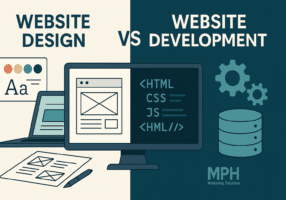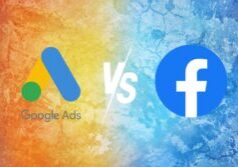If you’re planning a new website or a redesign, you’ve likely heard the terms website design and website development. These two roles sound similar, but refer to very different aspects of building a website. Understanding the difference between web design and web development is crucial for business owners and marketing managers. It helps you decide what expertise your project needs and ensures you invest in the right resources. In this post, we’ll break down website design vs development – what each entails, how they differ, and why your website needs both to succeed.
What is Website Design?
Website design focuses on the look and feel of a site – in other words, how your website appears to users and how it functions from a user experience perspective. A web designer is concerned with visual elements like layout, color scheme, typography, images, and interactive features that shape the visitor’s experience. In practice, web design involves creating the UI/UX (user interface and user experience) blueprint for the site. This often includes:
- Planning the layout and navigation: Designing page structure, menus, and how content is organized for easy browsing.
- Visual aesthetics: Choosing color palettes, fonts, and imagery that reflect the brand and appeal to the target audience.
- Wireframes and mockups: Drafting skeletal outlines and detailed mockup designs of pages (using tools like Sketch, Figma, or Adobe XD) before any code is written.
- Interactive design: Ensuring buttons, forms, and links are placed intuitively and considering hover effects or animations that enhance usability.
A good web designer’s goal isn’t just to make a website “pretty,” but purposeful. They craft each element to support the site’s goals – whether that’s conveying a brand identity or guiding users toward a call-to-action. Many web designers consider themselves problem-solvers for usability and conversion, not just graphic artists. They think about how to create a cohesive brand experience and an intuitive interface that makes visitors stay and engage.
Do web designers code? Not usually – at least not heavy programming. Web design is generally the first phase of creating a website, and designers often hand off their visual concepts to developers for implementation. However, modern web designers do benefit from knowing some basics of front-end code (HTML and CSS) because it helps them understand the medium. In some cases, designers use no-code tools or content management systems (like WordPress or Wix) to build prototypes or even live sites without writing much code. Still, any complex functionality or custom feature will require development to bring it to life.
What is Website Development?
Website development is all about building and maintaining a functional website based on the design. If design is the blueprint, development is the construction work that makes the blueprint a reality. A web developer takes the visual mockups and concepts provided by the design and writes the code that powers the site. This coding can be broadly split into two categories:
- Front-End Development: This refers to coding the parts of the website that users see and interact with in their browser. Front-end developers use languages like HTML, CSS, and JavaScript to translate design elements into a live webpage. They ensure that the layout, fonts, and interactive elements match the designer’s vision and that the site looks good on various devices (responsive design).
- Back-End Development: This covers the server-side and database aspects that users don’t see directly. Back-end developers work with languages and frameworks (like Python, PHP, Java, Ruby, Node.js, etc.) to handle the behind-the-scenes functionality – think of features like user logins, form submissions, e-commerce transactions, or any dynamic content. They make sure data is processed correctly and served to the front-end when needed.
In many web projects, you’ll have both front-end and back-end developers, or a full-stack developer who can do both. Web development focuses on the mechanics that allow a site to work correctly , ensuring pages load quickly, links and buttons function, forms submit data, and the overall site is stable and secure. Developers also handle technical tasks like setting up web hosting environments, databases, integrations with other systems, and ongoing maintenance or debugging.
In short, where designers create the vision for how a site should look and feel, developers make it work in reality. Without development, even the best design would just be an image file, not an interactive website.
Web Designer vs Web Developer: Key Differences
It’s easy to confuse these roles since both are essential to building a website. However, web design vs. web development involves different skill sets and responsibilities. Here are the key differences:
- Focus and Responsibilities: A web designer concentrates on aesthetics and user experience – how the site looks, flows, and engages the user. A web developer focuses on functionality and technical implementation – how the site runs and performs behind the scenes. Designers produce creative assets (layouts, graphics, prototypes), whereas developers produce a functional site through code.
- Skills and Tools: Web designers use design tools like Adobe XD, Figma, or Photoshop, and they apply knowledge of color theory, typography, and layout principles. They might also be familiar with basic HTML/CSS to understand feasibility. Web developers, on the other hand, use programming languages and development frameworks. Front-end developers code in HTML, CSS, JavaScript and use frameworks/libraries (like React or Vue.js), while back-end developers use languages like PHP, Python or Java along with databases (SQL, etc.). Their toolkit is all about coding, version control, and debugging.
- Output/Deliverables: The deliverables from a designer might be design files or style guides – essentially a visual plan of the website. From a developer, the deliverable is the live website itself – the codebase and site files that users can visit in a browser. For example, a designer might provide a mockup of a homepage, and the developer will turn that mockup into a working web page.
- When They’re Involved: Design typically comes first in the website creation process (planning the look/structure), and development follows to build it. In iterative projects, designers and developers collaborate closely: the designer may refine visuals while the developer codes, ensuring feasibility. In some cases, especially with modern website builders, these roles overlap – but generally, you design before you develop.
- Interdependence: Web designers and developers work hand-in-hand. A designer’s work sets the stage for the developer’s work. Conversely, technical limitations or possibilities from the development side can influence design choices. For instance, a developer might advise if an animation or layout requires a certain approach to implement. Despite being different disciplines, there’s often an overlap; many designers have a bit of coding knowledge, and many developers have an eye for design. This overlap can help streamline projects, but doesn’t replace deep expertise in each area.
Overall, the difference between web design and development boils down to creative vision vs. technical execution. Both are vital, and neither is more important than the other. Industry experts emphasize that investing in both good design and solid development is essential for an exceptional user experience.
Do You Need a Web Designer or a Web Developer?
From a business owner’s perspective, the lines can be blurry. If you’re not familiar with tech roles, you might wonder who to hire for your website project – a designer, a developer, or both. Here are some practical insights to help you decide:
- New Website or Complete Redesign: If you’re building a brand new website from scratch (or doing a full overhaul of an old site), you will need both web design and web development. Start with a web designer to plan the site’s appearance, branding, and user journey. Once the design is approved, a developer (or development team) will create the actual website according to that plan. Many agencies offer both services in-house, ensuring a smooth handoff from design to development.
- Improving Look and User Experience: If your current site functions well but looks outdated or isn’t converting visitors, a web designer can help. They might refine your site’s layout, update the styling, make it mobile-friendly, and improve the user interface to better guide users. In implementing these changes, some development work will likely be needed (to apply the new designs to the code), but the primary focus is on design improvements.
- Adding Features or Fixing Functionality: If your site’s design is fine but you need new functionality (like adding e-commerce capabilities, a web application feature, integrating a database, or fixing slow performance and bugs), then you need a web developer. A developer can enhance your site’s capabilities or optimize its performance without necessarily changing the visual design. Back-end developers are crucial if you’re dealing with server-side features or complex integrations (for example, connecting your site to a CRM or external API).
- One-Person Website Builds: For small projects or limited budgets, you might be considering hiring someone who can do it all. There are full-stack web developers who have proficiency in both design and development. Additionally, modern website builder platforms (WordPress with themes, Squarespace, Wix, etc.) allow a tech-savvy designer to construct a decent site with minimal coding. If your project is straightforward (like a basic marketing website), a skilled individual or small team with mixed expertise can suffice. Just be sure that the person truly has the range of skills required – ask for portfolio examples that demonstrate both attractive design and solid functionality.
In summary, assess your project’s needs. If you find that your website needs a new look and better UX, go for design (and expect some dev assistance to implement it). If you need technical improvements or complex features, go for development. And for anything but the simplest sites, plan to involve both at different stages. Often the best results come when designers and developers collaborate from the beginning so that the final site is both beautiful and functional.
Why Both Design and Development Are Essential for a Successful Website
A successful website is the sum of many parts. Web design and web development are like two sides of the same coin – each side is needed for the coin to have value. From the user’s viewpoint, design and development together create the overall user experience. Here’s why you shouldn’t neglect either:
- First Impressions and Engagement: Users form an opinion about a website within seconds based on its design. A professional, modern design makes your business look credible and invites users to stay. This includes mobile-responsive design and accessibility considerations so everyone can use your site. Without good design, your site may fail to engage visitors long enough to show them what you offer.
- Functionality and User Satisfaction: Even the most stunning design means nothing if the site is broken, slow, or confusing to use. Robust development ensures the site loads quickly, links don’t break, forms and features work correctly, and the site is secure. Good development directly impacts SEO (site speed, code structure) and user trust (no one likes a site that crashes or errors out).
- Conversion and Goals: Your website likely has goals – purchases, lead sign-ups, inquiries, etc. Design contributes by guiding the user’s eye to key elements (like call-to-action buttons) and creating an intuitive journey. Development contributes by implementing the needed functionality (like shopping carts, contact forms, analytics tracking) to actually enable those conversions. Without development, those “Buy Now” buttons wouldn’t do anything; without design, users might not even notice or be inclined to click them.
- Long-Term Growth: Web trends and technologies evolve. A good design makes it easier to update the look or add new content down the line, while a solid development foundation makes it easier to extend functionality. If your site is designed and built well from the start, future edits or expansions will be smoother, saving time and cost in the long run. Conversely, skimping on design or development can lead to costly overhauls later if the site isn’t performing (e.g., high bounce rates due to poor design or frequent issues due to bad code).
Think of web design and development as a partnership. The best websites arise when designers and developers collaborate, ensuring the site’s form (design) complements its function (development). As one top website consultant puts it, both roles work in tandem to craft an engaging, functional, cohesive website. For business owners, that means your project should budget for and prioritize both aspects.
Conclusion
In the debate of website design vs development, the winner is… both. They serve different purposes, but you need each piece to build a successful online presence. By clearly defining what web designers and web developers do, you can make informed decisions when planning your website. If you want a site that not only looks amazing but also works flawlessly, ensure you have access to both creative design expertise and technical development skills. Understanding the difference between these roles will help you communicate better with your team or agency, set realistic expectations, and ultimately achieve a website that is visually appealing, user-friendly, and powerfully functional – a true asset to your business.
Remember, a well-designed website attracts and engages visitors, and a well-developed website converts and serves those visitors. When you combine the strengths of web design and web development, you’re setting the stage for online success. Embrace both, and your website will be far better positioned to impress users and achieve your business goals.
Lets Talk










